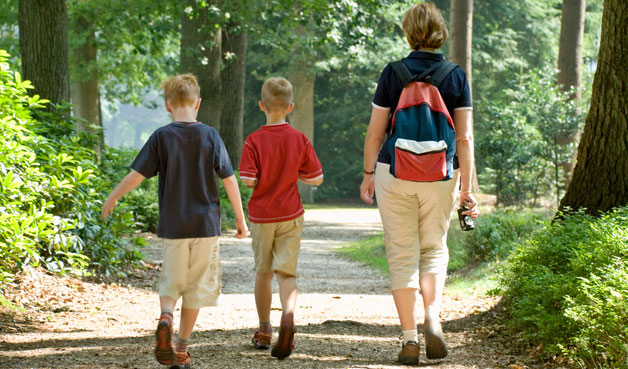How to Design a Nature Trail
Marina D’Abreau Denny, Extension Associate
Published 2/20/14

Creating a nature trail is a great way to attract and benefit from our natural wildlife resources and provide visitors with quiet time away from the demands of everyday life. A properly designed and managed trail can provide a venue for educational, economical and recreational opportunities for many groups of people. The struggle is to find the right balance between providing the greatest benefit for wildlife and maximizing the recreational enjoyment of the people that use the trail.
Planning, Design, Construction, and Maintenance
The goal when designing a trail is similar to designing a backyard habitat.
- Include the basic needs of targeted wildlife, including food, water, shelter/cover, and a place to reproduce and raise young.
- Remove as many invasive exotic plants as possible, and encourage a diversity of native vines, ground covers, shrubs, and trees.
- Plan for as many habitat types as are feasible and functional on your land (e.g. meadow, pond, forest, wetland, etc.)
- Design plant arrangements in order to achieve vertical layering. This is important because some wildlife species may use the ground layer vegetation (herbaceous) for food, but also need the tallest layer (tree canopy) for shelter.
Another consideration when designing a nature trail is to include a buffer area that will allow for human disturbance. This can be as simple as a vegetated space between the active trail and the wildlife habitat which diminishes our disruption of a natural setting.
Accessibility
In the United States, one in five individuals has some type of functional limitation that substantially limits one or more major life activities. Recreational opportunities offer people with disabilities the opportunity to enjoy life, benefit from the experience and contribute to their own sense of health and wellness. Ensuring that your trail is accessible can create more opportunities for people with disabilities to participate with their families and friends.
There is also a business aspect to providing programs and facilities that are accessible to people with disabilities. Accessible facilities and programs can increase the number of prospective visitors, their family members and friends, thus increasing participation and added revenue.
Now, this is easier said than done, since trails provide unique outdoor experiences that at times may be difficult to make accessible while maintaining the natural elements. Additionally, accessibility requirements vary for each individual. To learn about accessible trail and greenway design, new projects, training opportunities, legal issues, and proposed federal guidelines, visit the American Trail web site at https://www.americantrails.org.
Other Considerations
To attract hikers to nature trails, provide well-maintained trails of varying difficulty – very easy to somewhat difficult. Designing trails that lead to interesting features such as an old tree, pond, overlook or other landscape feature provides an end goal for the user to use the trail. Additionally, using the landscape (hills, slopes, etc.) to direct the layout of your trails will not only reduce possible maintenance issues (e.g., erosion) but it will also add intrigue to the trail by adding bends and turns masking what is around corner from the user's eye. Provide users with a detailed map of the property, including interesting stops and any potential dangers.
As with any business, landowners must be sure to acquire proper liability insurance and permits for building recreational trails in their area. Certain amenities such as picnic areas and restrooms help make trails more popular, but are not necessary. Overall, hikers are simply looking for a memorable and enjoyable experience in nature.
Additional Helpful Sources
- Nature Trails: Planning, Design, Construction, and Maintenance, https://www.naturalresources.msstate.edu/business-resources/types/nature-trails.php
- Developing Trails and Tourism on Private Lands in Texas (for-sale publication), https://agrilifebookstore.org/
- Recreational Forest Trails: Plan for Success, https://content.ces.ncsu.edu/recreational-forest-trails-plan-for-success

